Last fall I tried a few grains of brewers yeast as a starter in a pint of habanero/bhut jolokia blend mash. It sure took off quick and started bubbling right away. I also used the liquid from yogurt on another jar and after a few months I taste tested and they both seemed good. Anyone have any comments on using small amounts of brewer's yeast as a starter?
-
If you have a question about commercial production or the hot sauce business, please post in The Food Biz.
You are using an out of date browser. It may not display this or other websites correctly.
You should upgrade or use an alternative browser.
You should upgrade or use an alternative browser.
tutorial Fermenting Peppers 101
- Thread starter RocketMan
- Start date
Sugar is the key. Peppers are naturally low in suger and apure pepper mash will ferment very slowly. When I set up a fermentation I put all of the ingredients of the eventual sauce less those I want to add at the end say to add some sweetness back to the sauce. Typically in a mash I'll add onion, carrots, garlic so there are plenty of sugers in there for it. There is no difference between the different peppers with the exception possible of sweet peppers versus hot peppers. It really is all about the sugers. There are some differences between the starters too. I also have noticed that I get a more vigerous ferments when using the whey from a tub of yogurt than with any others.
The movement action of the mash is because the air bubles typically become trapped within the mash and this causes the mash to rise and fall. using some glass beads in some cheese cloth set on top of the mash will help to keep it from rising.
Have a great week,
RM
The movement action of the mash is because the air bubles typically become trapped within the mash and this causes the mash to rise and fall. using some glass beads in some cheese cloth set on top of the mash will help to keep it from rising.
Have a great week,
RM
another question, if lets say you were gonna do a mash of just peppers, water salt and starter, could u add a little sugar to feed the starter like yeast or would that negatively effect the outcome of the mash?
Awesome thread, just what I was looking for. Nothing like some fermentation products to get your day started right.
I was wondering if anybody has noticed much difference in flavor from different starter cultures. When making fermented milk products, the old-school producers will always start the next batch with some whey from the old batch to keep the unique flavor of that particular mix of microbes. There are lots of different yogurts available now with different live cultures, anybody do any taste comparisons?
Re: grilling first. I don't know about bacterial fermentation, but in beer making, toasting the grain converts some of the sugars into a form that is not easily digested by the yeast, which results in more residual sugars after the fermenting is done. There is one sure way to find out, try it and see how it tastes!
I was wondering if anybody has noticed much difference in flavor from different starter cultures. When making fermented milk products, the old-school producers will always start the next batch with some whey from the old batch to keep the unique flavor of that particular mix of microbes. There are lots of different yogurts available now with different live cultures, anybody do any taste comparisons?
Re: grilling first. I don't know about bacterial fermentation, but in beer making, toasting the grain converts some of the sugars into a form that is not easily digested by the yeast, which results in more residual sugars after the fermenting is done. There is one sure way to find out, try it and see how it tastes!
First of all, this has been a great informative forum topic and this is actually my first real post. I was hoping to get some feedback on what I've done in the past year and what I plan to do this year. Last year was the first time I grew peppers(Hanoi red, Aji, and Thai dragon). I went to my cousins organic farm and she sent me home with a jug of whey and a prized cookbook they sell which is all about cooking with natural ingredients in healthy ways for very self sufficient people. The recipe for fermenting vegetables could not have been more simple. Fill a jar half way up, add 1 tablespoon of whey, fill it 1 inch from the top add another, and I may have added some sea salt mixed in. Fermentation started in about 8 days and the lids may have puffed out and bent a little with some run off that somehow squeezed through, but no explosions or anything. I kept them out about 7 months and now the last few quarts are in the fridge.
I was under the impression that I should go a head and mix the other ingredients with the peppers prior to fermentation so that everything fermented together and so the flavors would begin to mix together during the months the jars were fermenting. Those ingredients included lime, carrots, garlic, and onions(typical Belize habenero sauce ingredients that I love). I actually used a juicer for everything and then took the pulp from the pepper and added some back into the sauce and then added the rest to chopped onion and garlic and oil for a chutney which I also fermented.
Everything turned out awesome. I added a little vinegar to some of my sauce to try it, but found it unnecassary. I've basically stopped buying hot sauce and eat mine with everything but fruit and dessert and love it as does everyone who tries it.
This year I'm growing yellow Bhuts, scotch bonnets, Yellow CARDIs, Lemon drop Aji, Pinquin, De Arbol, and Cajamarca.
After reading this forum and went and got 7 airlocks at the brew store and brew jugs with opening big enough to get all my pepper in. I didn't feel like drilling holes into mason jars. I can fit 3 fingers in the opening. Is there any problem with that as opposed to wide mouth mason jars. It seems easier to keep the pepper weighted down with less air space. Also, when I fermented last year, I turned the jar upside down every other day to mix the ingredients. Was that bad? What are everyone's thoughts on premixing ingredients or using a juicer?
I was under the impression that I should go a head and mix the other ingredients with the peppers prior to fermentation so that everything fermented together and so the flavors would begin to mix together during the months the jars were fermenting. Those ingredients included lime, carrots, garlic, and onions(typical Belize habenero sauce ingredients that I love). I actually used a juicer for everything and then took the pulp from the pepper and added some back into the sauce and then added the rest to chopped onion and garlic and oil for a chutney which I also fermented.
Everything turned out awesome. I added a little vinegar to some of my sauce to try it, but found it unnecassary. I've basically stopped buying hot sauce and eat mine with everything but fruit and dessert and love it as does everyone who tries it.
This year I'm growing yellow Bhuts, scotch bonnets, Yellow CARDIs, Lemon drop Aji, Pinquin, De Arbol, and Cajamarca.
After reading this forum and went and got 7 airlocks at the brew store and brew jugs with opening big enough to get all my pepper in. I didn't feel like drilling holes into mason jars. I can fit 3 fingers in the opening. Is there any problem with that as opposed to wide mouth mason jars. It seems easier to keep the pepper weighted down with less air space. Also, when I fermented last year, I turned the jar upside down every other day to mix the ingredients. Was that bad? What are everyone's thoughts on premixing ingredients or using a juicer?
DocNrock glad you like the read. I haven't tried with smoked peppers but it would be a great experiment to try.
PepperWhisperer - I have used whey from yogurt and the hooch from sourdough bread and haven't noted any difference in the taste of the final product. I have noted difference based on time though. I always run mine 45 to 90 days based on how much sugar is in the mash. Beyond that to me is just mellowing and making the sauce even better.
Cellscape - I'm glad you liked it. Sounds like you have a great source there. I always ferment all of my ingredients unless I'm holding one back for a reason such as adding some sweetness to the sauce. One note, be very careful about adding oil to your sauces. Oil as with all fats can cause a sauce to go rancid quickly if not done peoperly. For a sauce that will be refridgerated and consumed within a week or so not really a big deal. However, in a fermentation that will be stored at 80 to 95 degrees F, the optimal range for Lactobacillus, it could ruin the sauce before it gets started. If you wanted toadd the oil as a part of the desired flavor profile such as adding some White or Black Truffle Oil or Avacado Oil then I'd do so as part of the final processing. JMHO
Cheers,
RM
PepperWhisperer - I have used whey from yogurt and the hooch from sourdough bread and haven't noted any difference in the taste of the final product. I have noted difference based on time though. I always run mine 45 to 90 days based on how much sugar is in the mash. Beyond that to me is just mellowing and making the sauce even better.
Cellscape - I'm glad you liked it. Sounds like you have a great source there. I always ferment all of my ingredients unless I'm holding one back for a reason such as adding some sweetness to the sauce. One note, be very careful about adding oil to your sauces. Oil as with all fats can cause a sauce to go rancid quickly if not done peoperly. For a sauce that will be refridgerated and consumed within a week or so not really a big deal. However, in a fermentation that will be stored at 80 to 95 degrees F, the optimal range for Lactobacillus, it could ruin the sauce before it gets started. If you wanted toadd the oil as a part of the desired flavor profile such as adding some White or Black Truffle Oil or Avacado Oil then I'd do so as part of the final processing. JMHO
Cheers,
RM
Avocado oil sounds really interesting. I may have to locate some and not just for hot sauce. Several of my peppers are just starting to turn ripe so my first fermentation jug may be a nice mix. I think I may remove the membrane and seeds from the really hot stuff like the Bhuts and then throw everything in the vitamix on a lower setting and juice all the additives(carrots, garlic, onion).
I also want to make a sauce with some ginger, mango, tumeric, and cumin.
I also want to make a sauce with some ginger, mango, tumeric, and cumin.
- 1 ripe medium mango or papaya (the smaller version, use only 1/2 if you use the large kind)
- 1/2 medium yellow onion chopped
- 2 medium garlic cloves
- 1 inch piece of ginger root, coarsely chopped
- 5 scotch bonnet of habanero peppers, de-stemmed
- 1/2 tsp. turmeric
- 1 tblsp dry mustard
- pinch of cumin, pinch of coriander
- 1/2 tblsp honey
- 1/2 cup water
- 1/2 cup cider vinegar
- 1 tsp sea salt
what about temperature of my home? Does that affect this any?
First time poster.
Wanted to contribute to this thread.
Preface by saying I have no idea about any of this stuff and am winging it, like I am sure alot of you guys are. If some of the science types see something wrong with what I am doing I would sure love some guidance.
Inspired by this thread and also faced with a mash that was 5 times as hot as I thought it was going to be, I decided to look into fermenting it before bottling in hopes of mellowing it out in some way. Whether that is a byproduct of fermenting I have no idea.
Didn't know anything about it. Did some research on the interwebs and meanwhile my mash is growing inside my mason jar and producing gas pockets and pressurizing.
Figured if I wasn't going to lose this stuff I needed to figure something out.
Here is my down and dirty solution / experiment.
I had a 3/4 full 1/2 pint jelly Bell canning jar full of roasted and coarse pureed pepper mix. added two pinches of Cumin infused Sea Salt.
Needed to create some kind of air lock system so I took a Pint Bell canning jar and the lid and ring from the 1/2 pint jar and sterilized them.
Put the mash in the pint jar.
added 2 1/2 tablespoons of juice from some greek yogurt. Just opened it up and there was the juice no problem.
added 3/4 tablespoon of pickling salt.
stirred vigorously
added bottled water till about 1/3 of inch of water covered mash.
took the ring of the jelly jar threads UP
put the lid into the ring seal DOWN
put my fingers inside the ring and fitted it into the pint jar until taut. (it did angle just a little bit. I couldn't get a really snug fit without the angle)
then I very carefully filled the ring, on top of the seal down lid, with pickling salt.
I did this based on the Budweiser of hot sauces method. Tabasco has all the steps on their website and it just seems cool that the salt lets the bubbling gas out but nothing in. (i hope)
Here are some pictures of the final product. I can document the whole thing if you think it's necessary.
THIS IS THE TOP VIEW
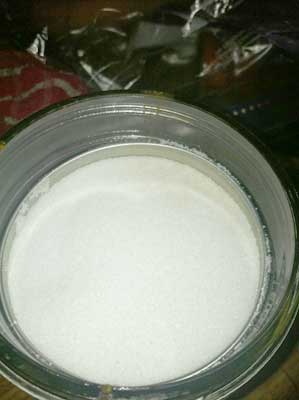
THIS IS A 3/4 VIEW
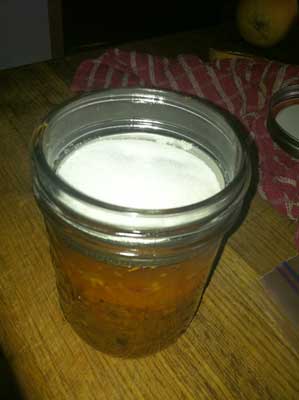
THIS IS A SIDE VIEW
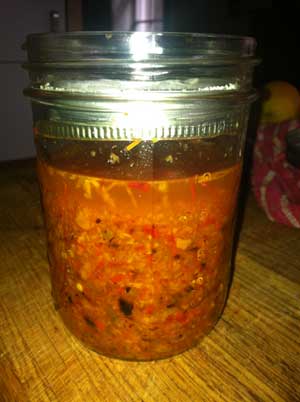
Thoughts? ideas? suggestions?
thanks for the great site. Hope to post some grow logs and harvest shots. we have 25 different pepper plants and 5 different tomatos and a tomatillo
Wanted to contribute to this thread.
Preface by saying I have no idea about any of this stuff and am winging it, like I am sure alot of you guys are. If some of the science types see something wrong with what I am doing I would sure love some guidance.
Inspired by this thread and also faced with a mash that was 5 times as hot as I thought it was going to be, I decided to look into fermenting it before bottling in hopes of mellowing it out in some way. Whether that is a byproduct of fermenting I have no idea.
Didn't know anything about it. Did some research on the interwebs and meanwhile my mash is growing inside my mason jar and producing gas pockets and pressurizing.
Figured if I wasn't going to lose this stuff I needed to figure something out.
Here is my down and dirty solution / experiment.
I had a 3/4 full 1/2 pint jelly Bell canning jar full of roasted and coarse pureed pepper mix. added two pinches of Cumin infused Sea Salt.
Needed to create some kind of air lock system so I took a Pint Bell canning jar and the lid and ring from the 1/2 pint jar and sterilized them.
Put the mash in the pint jar.
added 2 1/2 tablespoons of juice from some greek yogurt. Just opened it up and there was the juice no problem.
added 3/4 tablespoon of pickling salt.
stirred vigorously
added bottled water till about 1/3 of inch of water covered mash.
took the ring of the jelly jar threads UP
put the lid into the ring seal DOWN
put my fingers inside the ring and fitted it into the pint jar until taut. (it did angle just a little bit. I couldn't get a really snug fit without the angle)
then I very carefully filled the ring, on top of the seal down lid, with pickling salt.
I did this based on the Budweiser of hot sauces method. Tabasco has all the steps on their website and it just seems cool that the salt lets the bubbling gas out but nothing in. (i hope)
Here are some pictures of the final product. I can document the whole thing if you think it's necessary.
THIS IS THE TOP VIEW

THIS IS A 3/4 VIEW

THIS IS A SIDE VIEW

Thoughts? ideas? suggestions?
thanks for the great site. Hope to post some grow logs and harvest shots. we have 25 different pepper plants and 5 different tomatos and a tomatillo
Thoughts? ideas? suggestions?
like the salt barrier method
you can probably sweep all the salt to the edges to cover the corner gap
between the lid and the glass, may try to pile it 1/2" above the metal for full coverage
maybe to remove can suck up the salt with the shop vac first to lose less into the mash?

like the salt barrier method
you can probably sweep all the salt to the edges to cover the corner gap
between the lid and the glass, may try to pile it 1/2" above the metal for full coverage
maybe to remove can suck up the salt with the shop vac first to lose less into the mash?

Just came across an old message that Chili Monsta had sent me with a link to a great, however perhaps a bit dry in the reading, information source on Fermenting fruits and vegetables. Have a look:
http://www.fao.org/docrep/x0560e/x0560e00.htm
Cheers
http://www.fao.org/docrep/x0560e/x0560e00.htm
Cheers
I am fermenting my first sauce and plan to bottle it so the ph must be low enough to be shelf stable. The mash consists of cayenne peppers and garlic at a 6 to 1 ratio. I mixed in 1/4 cup of whey from natural yogurt and added an inch of sterile water with 1tbsp pickling salt per cup water in a 2 gallon jar. Fermentation was strong in 30 hrs. and after 2 weeks there are no signs of wild yeast growths. My plan is to finish the sauce in 4 weeks but I'm not sure if I should add vinegar to ensure a safe ph or just assume that a complete fementation gets me there. I don't plan to purchase a ph meter at this time and I don't know if ph strips can be accurate with a colored liquid.
Check out this disertation on tbasco production it seems to indiacte that fermentation alone will acheive a ph <4.0
http://etd.lsu.edu/docs/available/etd-07122005-142543/unrestricted/Koh_thesis.pdf
Check out this disertation on tbasco production it seems to indiacte that fermentation alone will acheive a ph <4.0
http://etd.lsu.edu/docs/available/etd-07122005-142543/unrestricted/Koh_thesis.pdf
The sauce will probably be good however without checking it there's no way to be completely certain. If you plan on making more sauces then a meter will be only a small investment and you can find them on ebay for under $20.00 US. Unless your planning on producing professionally the inexpensive meter will do fine for you.
If your not going to pick up a meter and don't want to try the strips then let it go a total of 6 weeks and then process the sauce but, since it's not tested, keep it in the fridge and don't keep it more than say 90 days to be safe.
If your not going to pick up a meter and don't want to try the strips then let it go a total of 6 weeks and then process the sauce but, since it's not tested, keep it in the fridge and don't keep it more than say 90 days to be safe.
Thanks RocketMan, sounds like the ebay $20 meter is accurate enough for my use. I should get one as I plan to bottle and hot process the sauce and still have 3 other sauces to make this year.
I see ebay has a pool and aquarium ph tester, yelow in color single probe for about $10. Anybody familiar with these?
I see ebay has a pool and aquarium ph tester, yelow in color single probe for about $10. Anybody familiar with these?
salsalady
Business Member
I went to the farmers market last week right at closing time and came home with ~45 pounds of jalapenos. In addition to pickling most of the pods, I decided to start another batch.
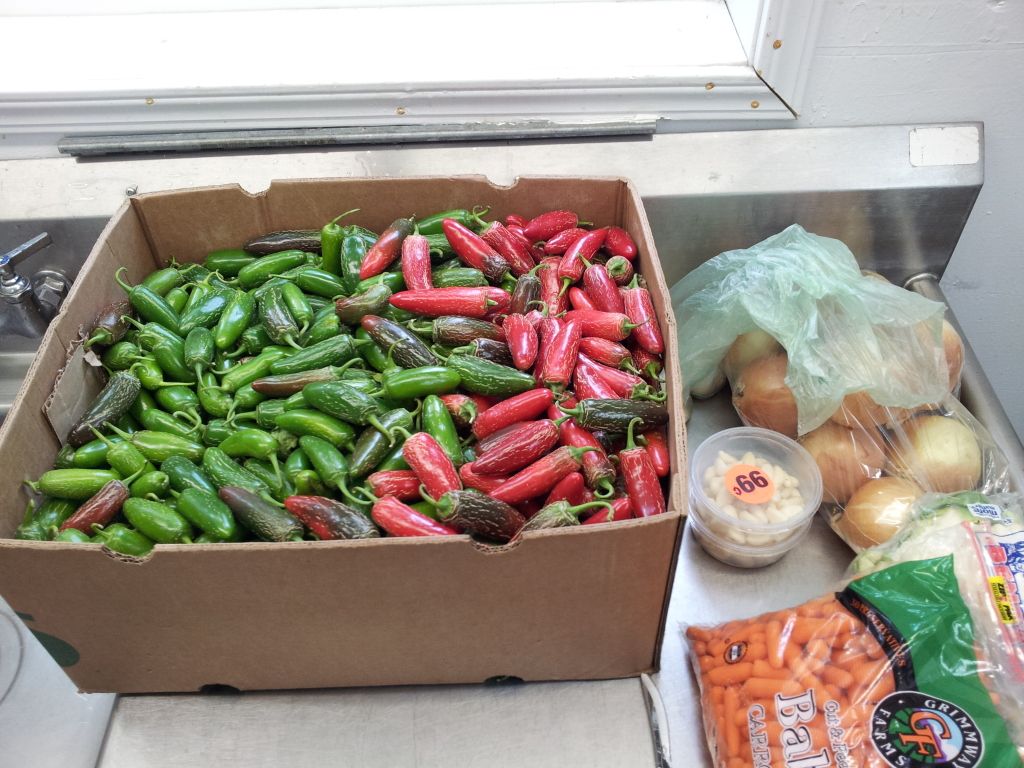
This post is mostly for the equipment options, so here's what's happened-
I ground up the jalapenos, garlic and onion, mixed up some Caldwell's fermented veggie starter, stuck it in the gallon jar with an airlock in the lid of the jar. 2 days later it looked like this- you can bairly see the airlock on the left side of the lid, and the pulp is so far up in the jar it's touching the airlock.
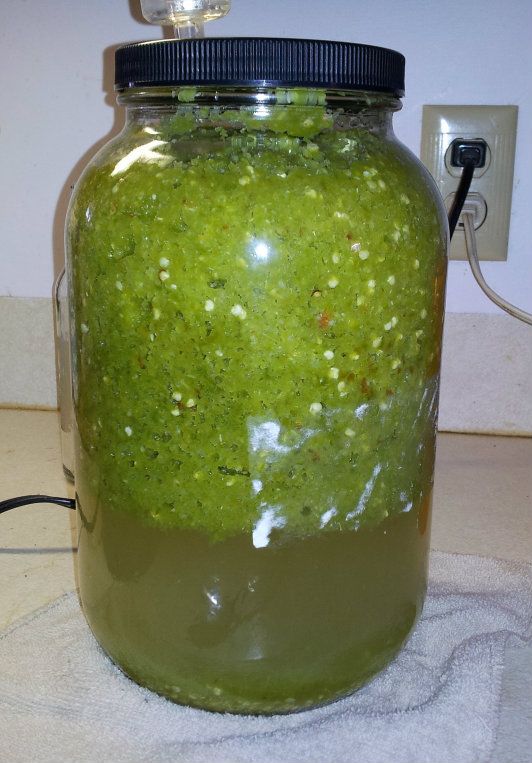
So, the airlock wasn't working, off to plan B-
Plastic bags and salt water-
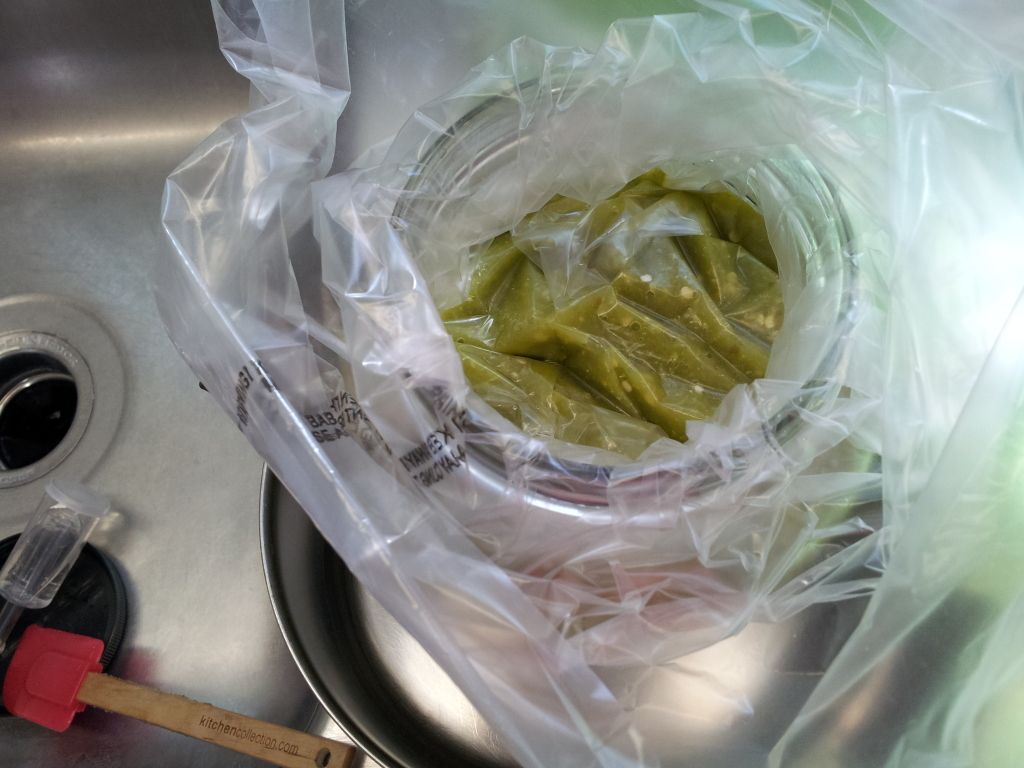
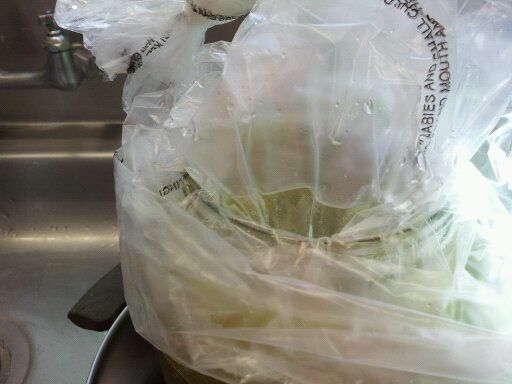
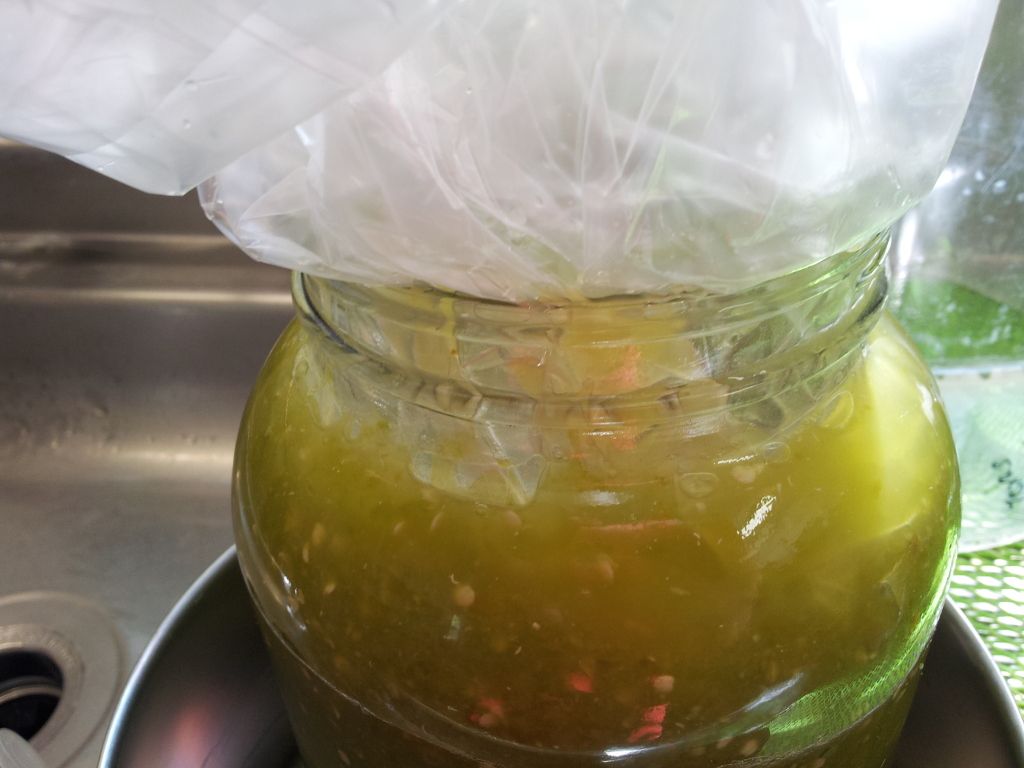
I had to move the jar out of the house as the kid and hubby didn't appreciate the smell. OH WELL! So far, the bag-lock seems to be working well. Maybe this'll be an option for others also. I think the airlock would have been fine if the jar had been less full.
OH WELL! So far, the bag-lock seems to be working well. Maybe this'll be an option for others also. I think the airlock would have been fine if the jar had been less full.

This post is mostly for the equipment options, so here's what's happened-
I ground up the jalapenos, garlic and onion, mixed up some Caldwell's fermented veggie starter, stuck it in the gallon jar with an airlock in the lid of the jar. 2 days later it looked like this- you can bairly see the airlock on the left side of the lid, and the pulp is so far up in the jar it's touching the airlock.

So, the airlock wasn't working, off to plan B-
Plastic bags and salt water-



I had to move the jar out of the house as the kid and hubby didn't appreciate the smell.

